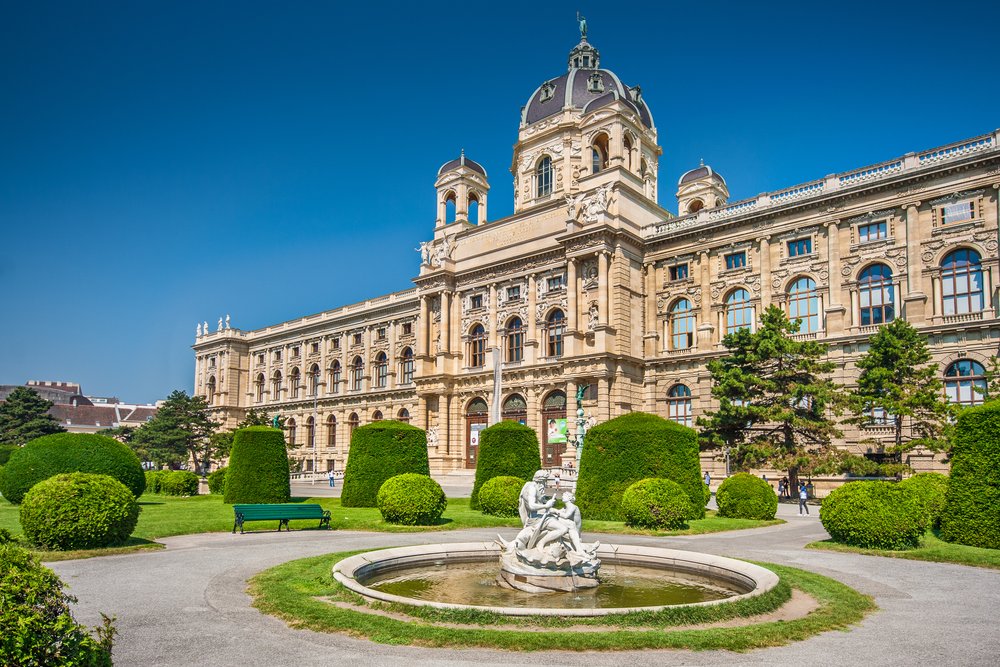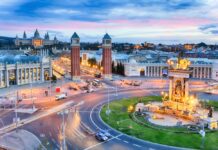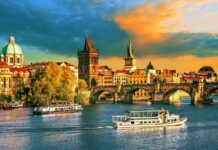A city that wears its history like a crowning jewel, Vienna welcomes visitors with grand opera houses, world-renowned museums, and exceptional art collections. But the story doesn’t end there. While the top attractions in Vienna are an overload of historical masterpieces, this city is more than its glamorous, time-turning facade. Mixing its cultural gifts with a dash of music, arts, and architecture, Vienna has something for every traveler. From the coziest wine taverns to a gigantic Ferris wheel, the city gives you the power to create lasting memories in a single trip.
Ready to take your trip to Vienna to the next level? Here are some of the things you need to know when you visit the top attractions in Vienna.
What to Expect When You Travel to Vienna
Currency: Euro (€)
Language: Viennese German, which is one of the Bavarian dialects, is the main language used in Vienna. But since the city is one of the most-visited European countries, English has become a prominent foreign language in it. While you may encounter senior residents who don’t speak English, communication is fairly easy when you transact in its shops and restaurants.
Transportation: Want to know an interesting fact about Vienna? It doesn’t have ticket barriers and fixed ticket checks for transport, making it convenient to travel around the city. Apparently, Vienna’s transport system runs on an honesty system, where you can randomly encounter conductors and transport authorities who check every passenger’s Fahrschein. Fahrschein is a ticket to buses, trams, trains, and subways, which are the four main modes of transport in the city.
Time Zone: Central European Standard Time (GMT+1)
Socket: Schuko (Type F sockets)
Weather: Vienna’s continental weather makes it easy to separate its cold and dry winter season from its warm summer days. Throughout the year, temperatures can vary between 27°F to 79°F. The warmest season starts from the end of May to the beginning of September, where temperatures peak at over 70°F. The cold season, which covers the months of November to March, experiences temperatures well under 45°F. January is the coldest month of the year.
Best Travel Times: The best time to travel to the top attractions in Vienna depends on your itinerary. The peak travel season in the city is between June and August, where the summer season offers tourists many opportunities to engage in outdoor activities.
Traveling to Vienna on a Budget
The top attractions in Vienna are, hands-down, some of the most impressive sites in Europe. But geographically speaking, it’s not surprising how visiting this city can also take a huge toll on your finances. It is, after all, still a European country. The goods news: it’s not as expensive as other European capital cities. To give you an insight, here are some of the common expenses you should prepare for once you book a trip to Vienna:
Food: For the most part, traveling to Vienna on a budget means skipping on fancy restaurants, especially the ones located in the city center. Food in this area can be really expensive since it is a tourist hub.
Just like traveling to other cities, the best way to cut down on expenses is to visit the local supermarket and prepare your food. The Naschmarkt is popular for housing 120 stalls that sell food and drinks. The second best option is to look for restaurants that offer two or three-course menus for only €5 to €10. Bonus tip: backpackers who are traveling to Vienna on a budget also take advantage of restaurants in Josefstadt and Neubau, which mainly offer student meals.
Vienna Hotels and Hostels: The rest of Austria would agree that Vienna hotels are more expensive as compared to the ones in its neighboring cities. The most budget-friendly Vienna hotels and hostels fall somewhere between €20 to €24 per night. You can also book an Airbnb, which can cut your accommodation costs by a fourth.
That said, traveling to Vienna on a budget is possible if you are willing to cut on some of the major travel expenses like food and accommodation. You can also take advantage of free guided tours and buy a Vienna card, which offers discounts for multiple entries to museums. The card also grants you discounts when you book the City Airport Train or the Airport Lines bus, along with a free travel pass on underground trams.
Top attractions in Vienna
Horse-drawn carriages, century-old palaces, and awe-inspiring cathedrals don’t only exist in fairytales. Held as a beautiful hostage of history, Vienna continues to mesmerize travelers with its well-preserved architecture and landscape. If you’re planning to book a trip to Vienna, here are some of the tourist spots you shouldn’t miss:
The Hofburg Palace
Reflecting a mix of Gothic, Baroque, and Rennaissance architecture is perhaps one of the most monumental palaces in Vienna, the Hofburg. Since 1275, the palace has become home to Austrian rulers. Inside the 59-acre palace complex are 2,600 rooms and 19 courtyards, which are located in its 18 buildings.
You can visit the Hofburg by booking the hop-on-hop-off tour offered by Vienna Big Bus. Here, you can spot some of the top attractions in Vienna, including the Sisi Museums, the Imperial Apartments, the Imperial Chapel, and the Silver Collection. If you are particularly interested in historical collections and relics, you can also stop by the Hofburg Treasury.
St. Stephen’s Cathedral
Located at Vienna’s historic center, St. Stephen’s Cathedral, also called Stephansdom, is amongst the most prominent churches in Austria. Since the 12th century, St. Stephen’s Romanesque architecture has met multiple developments that started in the 13th century.
Massive developments followed suit at the turn of the 14th century when the cathedral then reflected Gothic architecture. This came with the construction of three chapels (St. Tirna, St. Catherine, and St. Eligius), along with a choir loft. The cathedral continued to undergo renovations as Austria continued to flip the pages of history, but the most significant redevelopment happened after WWII when it had to be completely rebuilt.
A huge part of Vienna’s rich history, St. Stephen continues to be the archbishopric’s cathedral church since the year 1722. When you step foot on its grounds, don’t forget to visit the North Tower, the Steffl’s Watch Room, and the Pummerin Bell.
The Prater
The Prater and its giant Ferris wheel tell a completely different story. As the biggest recreation center in Vienna, this 3200-acre theme park, which sits near the Danube canal, has something new, something old, and something unforgettable for every type of traveler.
In the early days, the Prater served as a hunting ground for royal families. But today, there’s nothing else here to hunt but exciting rides and recreational activities. One of its biggest highlights is its Giant Wheel, which gives you incredible views of the city. If you’re not traveling to Vienna on a budget, you can also book its luxurious cabin, which can sit up to 12 persons. Inside the cabin is a table set that includes snacks and refreshments, making it the perfect spot for a romantic date. But, of course, this cabin doesn’t come cheap. A 30-minute ride can cost you over €190, which is a lot more expensive than the €10 cabins.
Other amenities in this recreation center include a dinosaur-themed park, a planetarium, and a variety of thrilling rides. You can also spot the Prater Museum, the Prater Ziehrer Monument, and the Liliputbahn miniature steam railroad here. Turn to every corner in Prater and you’d surely find amazing and fun-filled activities that can make your trip to Vienna more memorable.
The Spanish Riding School
Riding a horse is one thing, but watching them take on balletic performances is another. The Spanish Riding School has quickly risen as one of the top attractions in Vienna for its elegant and one-of-a-kind setting.
Locally called Spanische Hofreitschule, the Spanish Riding School started when the late Emperor Maximilian II introduced his immaculate Lipizzaner horses back in 1562. Today, tourists continue to flock into the area to witness dressage performances that are accompanied by classical music. Flaunting a mix of great music and artistic pirouettes and jumps, there’s no need to wonder why the tickets here sell out fast.
The Vienna State Opera House
A trip to Vienna will never be complete without a sneak peek to the Vienna State Opera House. A world-renowned theater that has staged thousands of performances from international artists, the Vienna State Opera House is as enchanting as its performers.
Built back in the late 1860s, this opera house flaunts French Early Renaissance architecture matched with glamorous interiors. From an elegant tea room to a grand staircase, the Vienna State Opera House looks nothing short of a fairy-tale-like castle.
Capable of putting 110 musicians on center stage, the opera house accommodates over 2,000 audiences without compromising sound quality. If you’re a fan of the orchestra, you’d be thrilled to learn that the Vienna State Opera House is home to the famous Vienna Philharmonic Orchestra. Watch a show or just simply enjoy its guided tours–everything about this opera house spells music and magic.
The Belvedere Palace
As one of the top attractions in Vienna, the Belvedere Palace proves its place in the city’s must-see sights through its incredible architecture and art collections. It is enlisted as a UNESCO World Heritage site for uncountable reasons.
The palace is made up of two Baroque buildings–the Upper and the Lower Belvedere. Inside the Upper Palace, also called Oberes, you’d see pristine statues that greatly complement its Ceremonial Staircase that is adorned with beautiful frescoes. The Lower Palace, on the other hand, is locally known as the Unteres. It houses a Marble Hall and a Marble gallery built to pay homage to historical statues.
The Belvedere Palace is also famous for its huge collection of artworks, including Gustav Klimt’s paintings. Outside the palace are enthralling French-style gardens that are made even more beautiful by an enormous display of fountains. Offering visitors a visual display of art and architecture, the Beldevere Palace also has a viewing platform at the top, where you can see Vienna in a different light.
The Schönbrunn Palace and Gardens
Another UNESCO World Heritage site makes it to our list of top attractions in Vienna–the Schönbrunn Park and Gardens. A welcome greeting to visitors of the equally-jaw-dropping Schönbrunn Palace, this Baroque garden is home to mind-sweeping vistas, mazes, and floral collections. Note that you’d have to pay to enter its maze, but if you want to go traveling to Vienna on a budget, skip the maze and go straight to the palace.
Once you enter the 18th-century-old Schönbrunn Palace, you’ll see a spectacular combination of architecture and art. This Baroque-style palace currently holds 1,441 apartments and rooms, including Imperial apartments and a room once occupied by Empress Maria Theresa.
Aside from its magnificent indoor and outdoor views, the Schönbrunn Palace and Gardens also has something for the kids and the animal lovers out there. If you have time to stroll around, visit the Schönbrunn Zoo, which is home to sea lions, pandas, and penguins. The palace also has a 50-meter outdoor pool which is perfect for beating the summer heat.
Historic Coffee Houses
Lastly, let’s skip the palaces and opera houses and move on to one of the things you can never separate from Vienna–coffee houses.
Booking expensive Vienna hotels aside, you can best experience the city by understanding its culture. Since Vienna is popular for its coffee-house culture, there’s no reason to not pay one of its historic coffee houses a visit. Even if you’re traveling to Vienna on a budget, you can still spot some cafes that can give you a great coffee-house experience.
A tradition that started back in the 17th century, the coffee-house culture in Vienna is recognized as an intangible cultural heritage by UNESCO. These coffee houses have been a popular go-to place for 19th and 20th-century intellectuals such as Sigmund Freud. And until now, the coffee house tradition continues to stay alive in the hearts of every local.
And, let’s face it. What better way is there to end your trip to Vienna than to enjoy a cup of world-class coffee?










